Heading out the door? Read this article on the new Outside+ app available now on iOS devices for members! Download the app.

Mention the word “Tantra,” and images of pretzel-like sexual positions often come to mind. The kinky reputation perhaps came about in 1990, when the musician Sting famously bragged about his seven-hour Tantric-sex sessions. While it’s true that a Tantra practice can include sex, the experience is actually a much deeper and more intimate connection than its wild reputation might imply, and the path can be taken outside the bedroom, too. Indeed, you can use Tantra Yoga to help you cultivate power as well as synergy, clarity, and confidence in every area of your life, whether your goal is to climb a career ladder, improve your relationships, or experience more joy in general.
The yoga that most of us are familiar with has its origins in Tantra. A major feature in the Tantric approach to yoga is the principle of shakti, which means “power” or “capacity.” According to Tantric philosophy, there is no energy in the world that is not in our bodies, and there is no energy in our bodies that is not in the world. According to Rod Stryker, founder of ParaYoga and one of the preeminent yoga, Tantra, and meditation teachers in the United States, you can embody shakti by mastering the energy in the body through many paths—asana, mantra (sound combined with feeling to protect and lead the mind), mudra (hand expressions of the heart), bandha (body locks in different locations, such as the chin, abdomen, and perineum), chakras (seven primary energy centers of the body), and breath. In doing so, you cultivate forces that include the power to know what decisions to make; the power of contentment; awareness of the highest truth; limitless willpower to achieve anything the mind is set on; and spontaneous right action. In other words, through Tantra, you can feel whole, make the right decision, and take action at the right time, in the right way, every time. “Embodying even a fraction of these forces empowers you to improve the quality of your life,” says Stryker. “Students of Tantra use the practice to reach their goals. They shift relationships and prosper in their careers. Their income levels increase, and even sex becomes more fulfilling.”
Tracee Stanley, a senior student of Stryker’s and a teacher of Tantra based in Los Angeles, turned to Tantra Yoga in 2001. A few years later, she used the practice to heal from a betrayal and broken heart. “Tantra is the way to overcome obstacles in the fastest way possible,” Stanley says. “At the heart of it, Tantra is the skillful use of energy. It gives us the tools to explore our inner energetic landscape and make meaningful transitions.”
Stryker designed the following all-levels sequence to help yogis experience the Tantra Yoga approach and its benefits. The sequence builds fire, energy, and power at the navel center—the third chakra, which is located at the solar plexus and is the seat of potency, vitality, courage, strength, and will—and moves it through each of the other chakras. The energy blossoms fully at the seventh, or crown chakra. The sequence culminates with a mudra and meditation that help you experience the full flowering of energy. By adding the Ram mantra, which cultivates the transformative power of fire or light, and the Tadaka Mudra (which translates as “empty lakebed”) at specific moments in the sequence, shakti can be awakened, according to Stryker. “You can experience more faith and less fear in general,” he says. “Instead of feeling anxious, you can enjoy increased confidence in all aspects of your life. It’s through the Tantra practice that these things really start to unfold.”
Read more about The Seven Chakras
Tantra Yoga Sequence for Confidence
Mountain Pose, standing arm raises
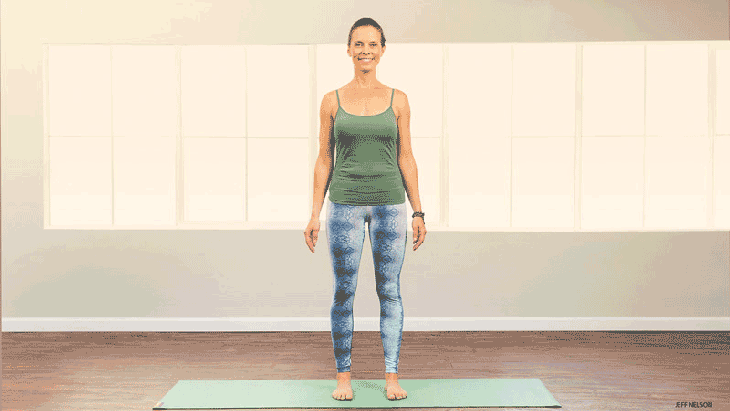
Tadasana
Stand tall with arms by sides and palms facing in, feet hip-distance apart. Engage the legs by drawing the shins toward each other and lifting the upper thighs. Lengthen the tailbone, lift the lower abdomen, and broaden the collarbones. On an inhale, bring your arms forward and overhead. Focus on filling the chest and upper back with breath. On the exhale, lower the arms and focus on contracting the navel toward the back body. On the last part of the exhale, squeeze and empty the lower lungs. Repeat 6 times.
See also Watch + Learn: Mountain Pose
Chair Pose, dynamic
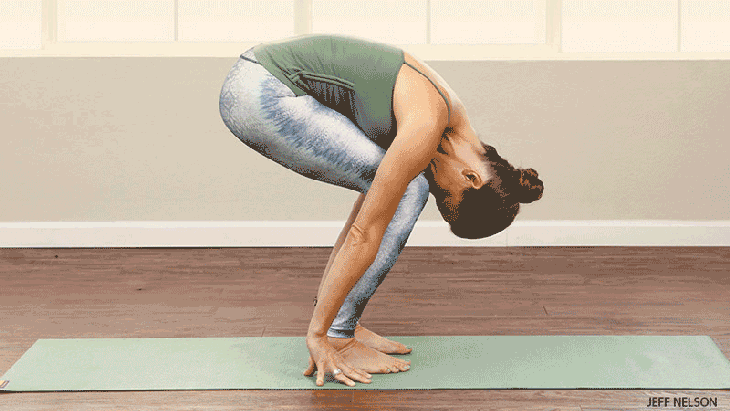
Utkatasana, dynamic
Stand with feet hip-distance apart. Inhale the arms overhead. On the exhale, slowly draw the navel toward the spine, bend the knees, and fold forward until the chest rests on knees. Hands rest on floor by the feet and the neck relaxes; make sure the sitting bones are not lower than the knees. On an inhale, slowly lift the arms overhead, lean (or sit) back into Chair Pose, and gradually straighten the legs; at the top of the inhale, the legs are straight. Repeat 5 times. On round 6, hold Chair Pose for 6 full breaths. On the inhale, focus on elongating the spine. As you breathe out, draw the tailbone down to stabilize and support the lower back.
Cow Pose to Downward-Facing Dog Pose

Bitilasana to Adho Mukha Svanasana
Come onto all fours, with hands shoulder-distance apart and knees hip-distance apart. On an inhale, move into Cow Pose by lifting the chest and lengthening the front body. Draw the tailbone down slightly to engage the lower belly. Begin to move into Downward Dog by curling the toes into the floor. On an exhale, straighten the knees, press the inner thighs back, and lift the weight of the hips away from the waist to lengthen the spine. Press the tips of your fingers and all your knuckles into the floor. Straighten the elbows. On an inhale, bring the knees slowly to the floor, keeping the abdomen engaged. Repeat the sequence 5 times. On round 6, hold Downward-Facing Dog Pose for 5 breaths. Focus on elevating the hips on the inhale and contracting the abdomen on the exhale. Keep the neck long, with the chin drawing slightly toward the throat.
See also 3 Ways to Make Downward-Facing Dog Feel Better
Warrior I Pose, variation

Virabhadrasana I, variation
Step your left foot 3.5–4 feet in front of the right. Bend the left knee so it stacks over the heel, with the foot pointing straight ahead at 12 o’clock. Keep the right leg straight and turn the left foot so toes point to 10 o’clock. Stack both hands over the navel. On an inhale, lift the arms overhead to just above shoulder height, with palms facing up. Expand the chest and emphasize lifting the spine and heart. On the exhale, lower the hands back to the abdomen. To avoid exaggerating the arch in the lower back, draw the tailbone toward the front heels. Stay for 1 full breath. On an inhale, raise arms again and repeat the sequence 5 times. On each inhale and exhale, mentally repeat the mantra Ram—the sound-body of light and transformational fire, which can help focus and build power in the navel center. Switch to the other side and repeat 5 times.
See also Kathryn Budig’s Dancing Warrior Moving Meditation
Wide-Legged Standing Forward Bend

Prasarita Padottanasana
Place feet a little wider than shoulder width (about 3–3.5 feet), with toes pointing forward. Start with hands on hips. On an exhale, hinge at the hips to fold forward and rest hands on the floor or a block. Draw the chin toward the throat to keep the back of the neck long and in line with the thoracic spine. Keep the spine long. Hold pose for 8–12 breaths. On each inhale, focus on lengthening the front body. On each exhale, focus on flattening the back and moving the navel toward the back body. Mentally repeat the Ram mantra and sense an awakening of transformational inner fire being lit in the space between the pubic bone and solar plexus (the area at the bottom of the breastbone).
See also Stretch Skillfully: Wide-Legged Standing Forward Bend
Fire Essence Practice
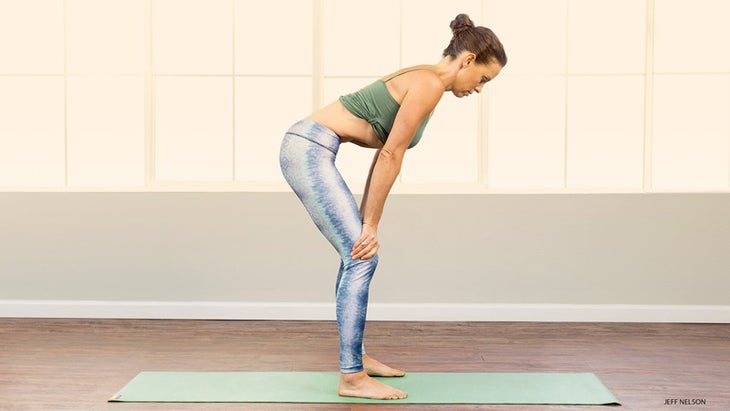
Agni Sara Kriya
Step your feet hip-distance apart. Bend knees and place hands on the lower thighs, just above the knees. Chin is slightly tucked in. On an inhale, lift the tailbone and soften the belly to create a slight arch in the lower back. On the exhale, draw the tailbone down and the navel toward the back body. Hold the breath out as long as is comfortable. Powerfully lift the abdomen, pulling it toward the back body and stretching the navel away from the pubic bone. Mentally repeat the Ram mantra. Slowly release the abdomen and then gradually inhale. Repeat 6 times.
See also Fire Up Your Love Life with Partner Yoga
Half Boat Pose, variation

Ardha Navasana, variation
Lie on your back, with your legs straight. Squeeze shins together and lift both heels 6 inches off the ground. Simultaneously lift the shoulder blades off the floor and engage the core. Draw the tailbone toward the heels and keep eyes and toes at the same level. Hold for 2 breaths. On an inhale, bend the left knee, bringing the thigh toward the chest. Hold for 2 breaths. Change sides by bending the right knee and bringing the thigh toward the chest. Hold for 2 breaths. Straighten both legs again and hold for 2 breaths. Repeat the 8-breath sequence 1–3 times. Feel the fire in the space between the pubic bone and solar plexus as you mentally repeat the Ram mantra throughout the sequence.
See also Belly Up to the Barre: 6 Yoga-Inspired Barre3 Poses to Try
Empty Lakebed
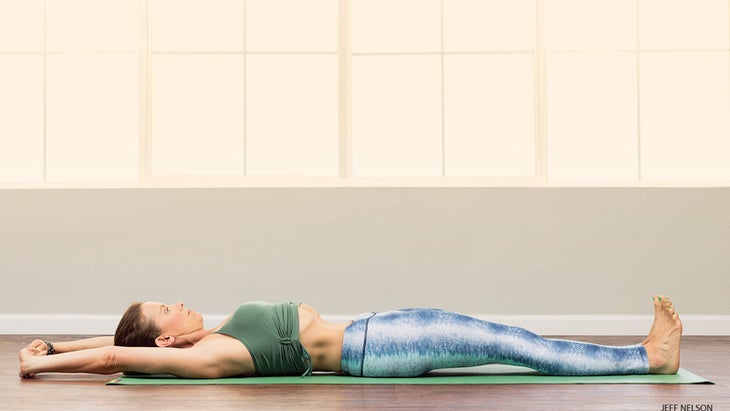
Tadaka Mudra
On an inhale, take both arms overhead and interlace the fingers. On the exhale, turn palms away from the head and lower the chin toward the collarbone. Begin to deepen the breath and keep the legs engaged. On each inhale, focus on lengthening the spine. On each exhale, contract the navel to stabilize and support the lower back. At the end of each exhale, hold the breath out as you draw the belly in and lift the chest higher from the waist. Repeat for 4–6 full breaths.
See also 3 Mudras To Plug Back In To Your Spirit
Corpse Pose
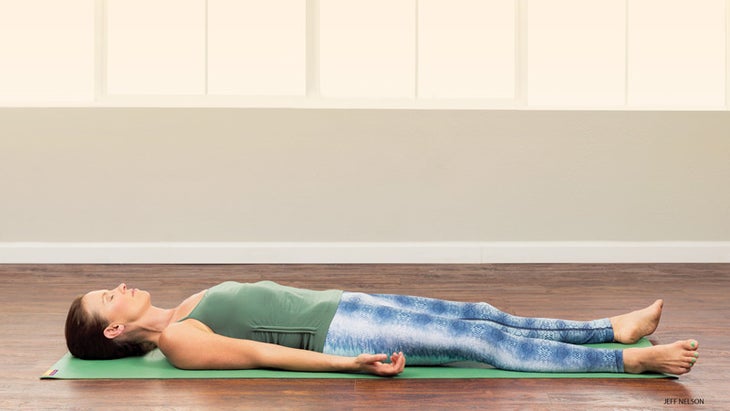
Savasana
Lie on your back. Place heels slightly wider than the hips. Arms are by your sides and your palms face up. Relax all facial muscles. Sense the eyes sinking into the sockets, and the forehead and scalp spreading. Take 5 slow, smooth breaths to soothe and relax the body and mind, then allow the breath to become automatic. Rest for 3–8 minutes, abiding in effortless awareness.
See also The Purpose of Corpse Pose
Yoga Mudra, variation
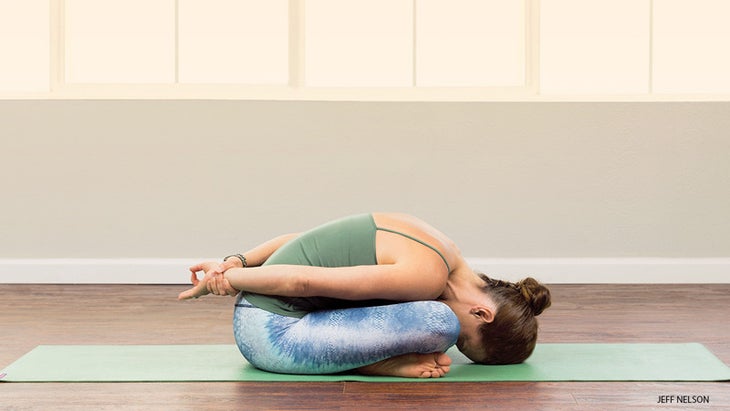
Assume a seated, crossed-legged position, placing heels wide apart and tucked as closely under the knees as possible. On an exhale, fold forward and place head on the floor or a block. Bring arms to rest on your back and take the right wrist with your left hand, bringing your right thumb and forefinger together. Hold for 8 breaths. Focus on the area between the base of the spine and the solar plexus while mentally repeating the Ram mantra.
See also 3 Yoga Mudras for Love, Focus, and Freedom
Prana Mudra
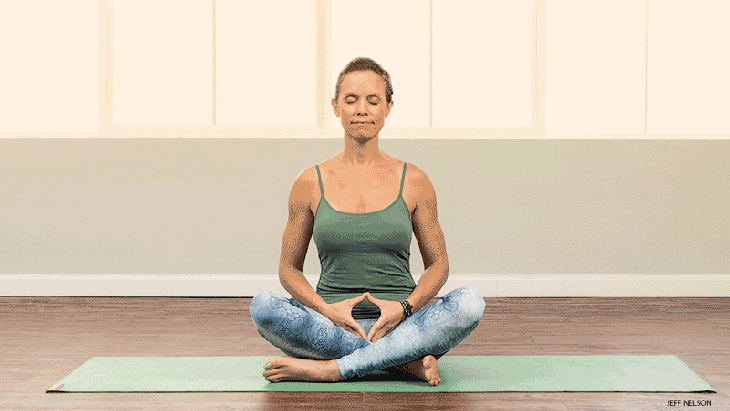
Assume a seated, crossed-legged position. If the knees are higher than the hips, sit on a folded blanket or cushion to elevate the hips. Bring hands into your lap. Fingertips and thumb tips touch and form the shape of a downward-pointing triangle. Close your eyes. Bring attention to the base of the spine—the location of your first chakra. Exhale completely and mentally repeat the mantra Om—the sound-body of universal consciousness—3 times. On an inhale, slowly raise the arms, palms facing up, to just above shoulder height. As your arms pass by each chakra, bring your attention to it, mentally repeating Om until you reach the seventh chakra. At the top of an inhale, retain the breath briefly with arms spread and palms facing up. Sense waves of joy and bliss rising through your body. Exhale slowly while lowering the hands, turning palms in to face the body, and mentally repeating Om at each chakra, until the hands rest back in the lap in the downward-pointing triangle. Return your awareness to the first chakra. Repeat 10 times.
See also Shiva Rea’s Pranam Mudra Vinyasa
Meditation

Rest in a seated meditation posture with a tall spine and eyes closed. Bring attention to the heart center. Allow the breath to flow effortlessly. Feel the sensations of awakened energy converge at the heart. Sense yourself resting in the heart as inner light and presence. Stay 2–5 minutes.
ABOUT OUR PROS
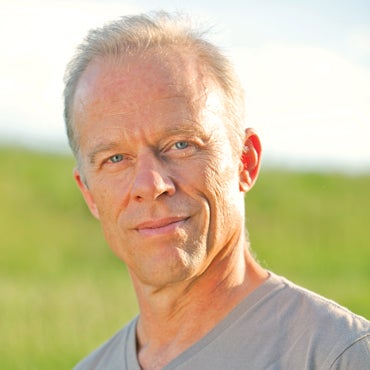
Teacher Rod Stryker is the founder of ParaYoga and one of the preeminent yoga, Tantra, and meditation teachers in the United States. Model Kerry Kleisner teaches yoga at True Nature Healing Arts in Carbondale, Colorado. She has studied ParaYoga since 2007.